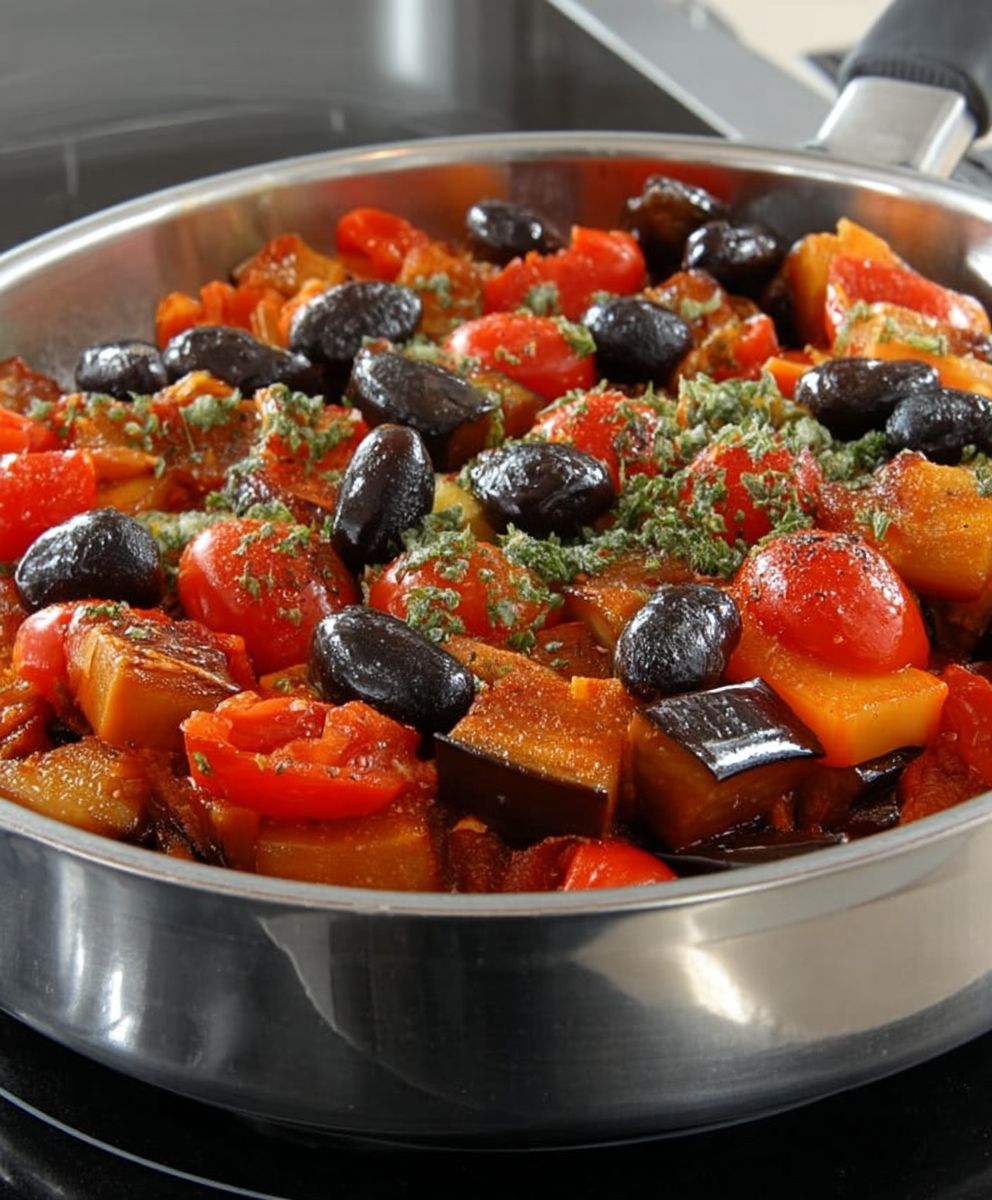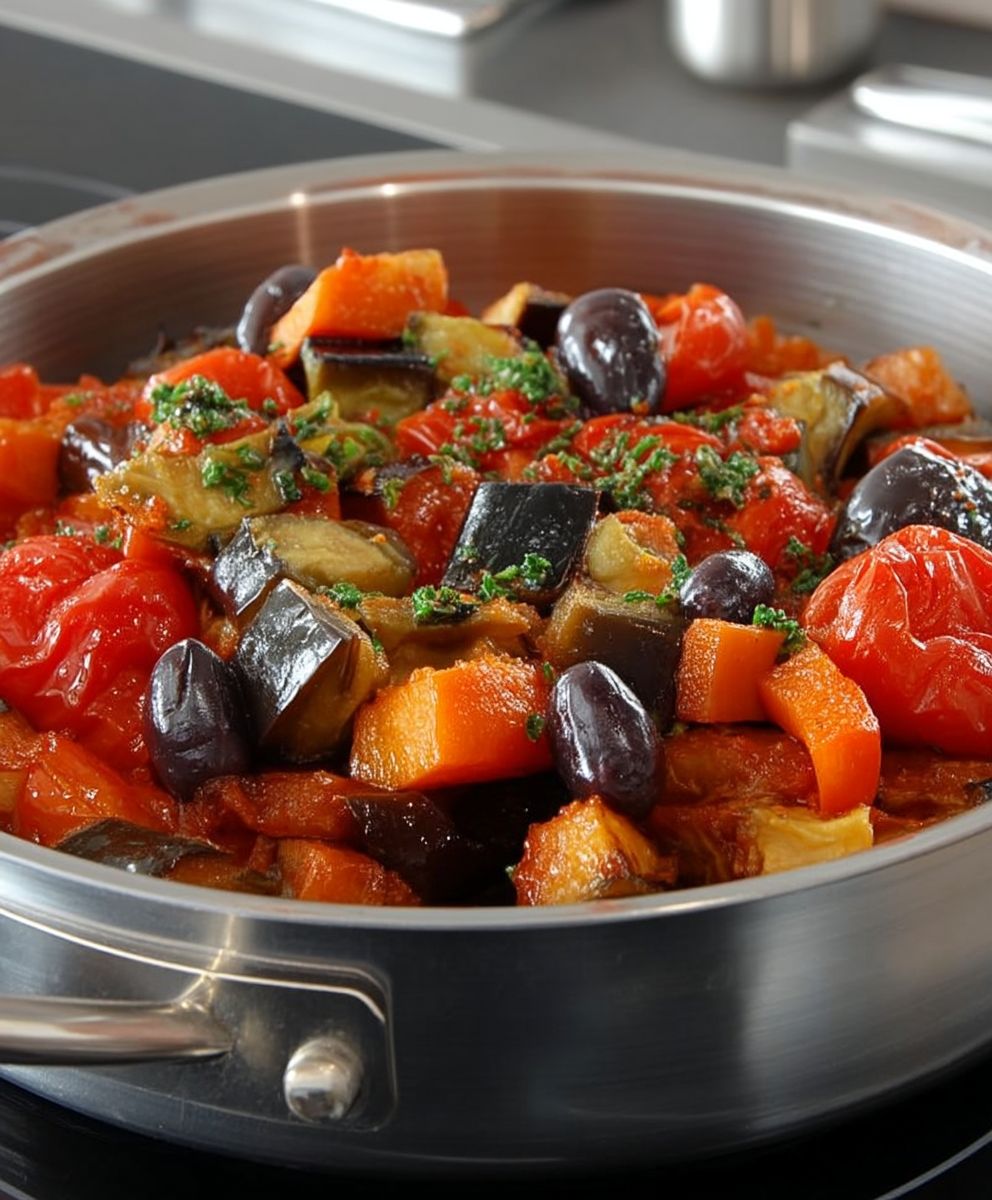Eggplant Tomato Caponata: Prepare to be transported to the sun-drenched shores of Sicily with this vibrant and flavorful dish! Imagine a symphony of sweet, sour, and savory notes dancing on your palate that’s the magic of Caponata. This isn’t just a recipe; it’s a culinary journey steeped in history and tradition.
Caponata, a beloved staple of Sicilian cuisine, boasts a rich history dating back centuries. Some believe it originated as a peasant dish, a clever way to utilize readily available vegetables. Others suggest a more aristocratic origin, evolving from a sweet and sour fish stew. Regardless of its precise beginnings, Caponata has become a symbol of Sicilian culinary ingenuity.
What makes Eggplant Tomato Caponata so irresistible? It’s the perfect balance of textures and tastes. The tender eggplant, juicy tomatoes, briny olives, and sweet raisins create a complex and satisfying experience. People adore it for its versatility it’s fantastic served as an appetizer with crusty bread, a side dish alongside grilled meats or fish, or even as a topping for pasta. Plus, it’s surprisingly easy to make, making it a weeknight-friendly option that will impress your family and friends. Get ready to experience a taste of Sicily with this authentic and delicious recipe!
Ingredients:
- 2 large eggplants (about 2 pounds total), cut into 1-inch cubes
- 1/2 cup kosher salt, plus more to taste
- 1/2 cup extra virgin olive oil, plus more for drizzling
- 1 large onion, chopped
- 4 cloves garlic, minced
- 1 red bell pepper, seeded and chopped
- 1 yellow bell pepper, seeded and chopped
- 1 (28-ounce) can crushed tomatoes
- 1/2 cup tomato paste
- 1/2 cup red wine vinegar
- 1/4 cup sugar
- 1/4 cup capers, rinsed and drained
- 1/2 cup green olives, pitted and sliced
- 1/4 cup fresh basil leaves, chopped
- 1/4 cup fresh parsley leaves, chopped
- Salt and freshly ground black pepper to taste
- Crusty bread, for serving
- Optional: 1/4 cup toasted pine nuts, for garnish
- Optional: 1/4 cup raisins, soaked in warm water for 15 minutes and drained
Preparing the Eggplant:
This step is crucial for drawing out the bitterness from the eggplant. Don’t skip it!
- Place the cubed eggplant in a large colander set over a bowl. Toss with the 1/2 cup of kosher salt, ensuring all the eggplant pieces are coated.
- Let the eggplant sit for at least 1 hour, or up to 2 hours, allowing the salt to draw out the excess moisture and bitterness. You’ll notice a dark liquid collecting in the bowl beneath the colander. This is exactly what we want!
- After the salting period, rinse the eggplant thoroughly under cold running water to remove the salt. Squeeze out as much excess water as possible with your hands. This step is important because you don’t want your caponata to be overly salty.
- Pat the eggplant dry with paper towels. The drier the eggplant, the better it will brown when we cook it.
Cooking the Vegetables:
Now comes the fun part! We’re going to build layers of flavor by sautéing the vegetables in stages.
- In a large, heavy-bottomed pot or Dutch oven, heat 1/4 cup of the olive oil over medium heat. Add the chopped onion and cook, stirring occasionally, until softened and translucent, about 5-7 minutes. You want the onion to be nice and soft, but not browned.
- Add the minced garlic and cook for another minute, until fragrant. Be careful not to burn the garlic, as it can become bitter.
- Add the chopped red and yellow bell peppers to the pot. Cook, stirring occasionally, until the peppers are slightly softened, about 5-7 minutes.
- Add the drained and dried eggplant to the pot. Increase the heat to medium-high and cook, stirring frequently, until the eggplant is golden brown on all sides, about 10-15 minutes. You may need to add a little more olive oil if the eggplant starts to stick to the bottom of the pot. The key here is to get a good sear on the eggplant, which will add a lot of flavor to the caponata.
Creating the Sauce and Simmering:
This is where all the flavors come together to create the classic caponata taste.
- Stir in the crushed tomatoes and tomato paste. Bring the mixture to a simmer, then reduce the heat to low.
- Add the red wine vinegar and sugar. Stir well to combine. The vinegar and sugar will balance the acidity of the tomatoes and add a touch of sweetness to the caponata.
- Add the capers and sliced green olives. Stir to incorporate. These ingredients add a salty and briny flavor that is characteristic of caponata.
- If using, add the drained raisins now. They will plump up during the simmering process and add a touch of sweetness and chewiness.
- Cover the pot and simmer for at least 30 minutes, or up to 1 hour, stirring occasionally. The longer the caponata simmers, the more the flavors will meld together. The sauce should thicken slightly.
- Taste and adjust the seasoning with salt and freshly ground black pepper as needed. Remember that the capers and olives are already salty, so be careful not to over-salt.
Finishing Touches and Serving:
Almost there! A few final touches will elevate your caponata to the next level.
- Remove the pot from the heat and stir in the fresh basil and parsley. The fresh herbs will add a bright and aromatic flavor to the caponata.
- If using, stir in the toasted pine nuts. They will add a nutty crunch to the dish.
- Drizzle with a little extra virgin olive oil. This will add a richness and sheen to the caponata.
- Let the caponata cool slightly before serving. Caponata is delicious served warm, at room temperature, or even cold.
- Serve with crusty bread for dipping. The bread is perfect for soaking up all the delicious sauce.
Serving Suggestions:
Caponata is incredibly versatile and can be enjoyed in many ways. Here are a few ideas:
- As an appetizer with crusty bread or crostini.
- As a side dish with grilled fish or chicken.
- As a topping for bruschetta.
- As a filling for sandwiches or wraps.
- Mixed into pasta.
- Served alongside cheeses and cured meats as part of an antipasto platter.
Make-Ahead Tip:
Caponata actually tastes better the next day, as the flavors have more time to meld together. You can make it a day or two in advance and store it in an airtight container in the refrigerator. Before serving, bring it to room temperature or warm it gently on the stovetop.
Variations:
Caponata is a very forgiving recipe, and you can easily adapt it to your own taste preferences. Here are a few ideas:
- Add other vegetables, such as zucchini, carrots, or celery.
- Use different types of olives, such as Kalamata or Cerignola.
- Add a pinch of red pepper flakes for a little heat.
- Use honey instead of sugar.
- Add a splash of balsamic vinegar instead of red wine vinegar.
- For a richer flavor, add a tablespoon of butter at the end of cooking.
Tips for Success:
- Don’t skip the salting step for the eggplant. This is essential for removing bitterness.
- Use good quality olive oil. It will make a big difference in the flavor of the caponata.
- Don’t overcrowd the pot when cooking the vegetables. Cook them in batches if necessary.
- Taste and adjust the seasoning as you go.
- Be patient and let the caponata simmer for at least 30 minutes. The longer it simmers, the better it will taste.
Storing Leftovers:
Store leftover caponata in an airtight container in the refrigerator for up to 5 days. You can also freeze caponata for up to 3 months. Thaw it overnight in the refrigerator before reheating.
Enjoy!
I hope you enjoy this classic Eggplant Tomato Caponata recipe. It’s a delicious and versatile dish that is perfect for any occasion. Buon appetito!

Conclusion:
And there you have it! Our Eggplant Tomato Caponata recipe, a vibrant and flavorful dish that’s sure to become a new favorite. I truly believe this is a must-try recipe for anyone who appreciates bold Mediterranean flavors and simple, wholesome ingredients. The combination of sweet, tangy, and savory notes, all brought together by the tender eggplant and juicy tomatoes, is simply irresistible. It’s a dish that’s both comforting and exciting, perfect for a cozy night in or a lively gathering with friends.
But why is this recipe a must-try, you ask? Beyond the incredible taste, it’s also incredibly versatile. It’s a fantastic way to use up summer’s bounty of fresh produce, and it’s surprisingly easy to make. Plus, it’s naturally vegetarian and can easily be made vegan by ensuring your honey or sweetener alternative is plant-based. It’s a dish that caters to a variety of dietary needs and preferences, making it a crowd-pleaser for any occasion.
Now, let’s talk about serving suggestions! I personally love serving this Eggplant Tomato Caponata as an appetizer with crusty bread or toasted baguette slices. The contrast between the warm, soft caponata and the crunchy bread is simply divine. You can also serve it as a side dish alongside grilled fish, chicken, or even tofu. It adds a burst of flavor and color to any main course.
For a heartier meal, try tossing it with pasta or serving it over polenta. The possibilities are endless! And don’t be afraid to get creative with your variations. Add a handful of Kalamata olives for a saltier, more intense flavor. Or, if you like a little heat, add a pinch of red pepper flakes. You could even experiment with different types of vinegar, such as balsamic or sherry vinegar, to create a unique flavor profile.
Here are a few more ideas to spark your culinary creativity:
Serving Suggestions & Variations:
* Bruschetta Topping: Spoon the caponata onto grilled bread rubbed with garlic for a delicious and easy appetizer.
* Pasta Sauce: Toss the caponata with your favorite pasta shape for a quick and flavorful weeknight meal. Consider adding some crumbled feta cheese for extra richness.
* Sandwich Filling: Use the caponata as a filling for sandwiches or wraps. It pairs well with grilled vegetables, hummus, or even a slice of provolone cheese.
* Pizza Topping: Spread the caponata on pizza dough before baking for a unique and flavorful pizza topping.
* With Eggs: Serve a spoonful of warm caponata alongside scrambled or fried eggs for a Mediterranean-inspired breakfast or brunch.
* Add Nuts: Toast some pine nuts or slivered almonds and stir them into the caponata for added texture and flavor.
* Spice it Up: Add a pinch of red pepper flakes or a drizzle of chili oil for a spicy kick.
* Sweeten it Up: Add a touch more honey or maple syrup for a sweeter caponata.
I’m so excited for you to try this recipe and experience the magic of Eggplant Tomato Caponata for yourself. It’s a dish that’s close to my heart, and I know you’ll love it just as much as I do.
So, what are you waiting for? Gather your ingredients, put on some music, and get cooking! And most importantly, don’t forget to share your experience with me. I’d love to hear how you made the recipe your own and what variations you tried. Leave a comment below, tag me in your photos on social media, or send me an email. I can’t wait to see your culinary creations! Happy cooking!
Eggplant Tomato Caponata: A Delicious & Easy Recipe
Sweet and sour eggplant relish with tomatoes, peppers, olives, and capers. Perfect as an appetizer, side dish, or topping.
Ingredients
- 2 large eggplants (about 2 pounds total), cut into 1-inch cubes
- 1/2 cup kosher salt, plus more to taste
- 1/2 cup extra virgin olive oil, plus more for drizzling
- 1 large onion, chopped
- 4 cloves garlic, minced
- 1 red bell pepper, seeded and chopped
- 1 yellow bell pepper, seeded and chopped
- 1 (28-ounce) can crushed tomatoes
- 1/2 cup tomato paste
- 1/2 cup red wine vinegar
- 1/4 cup sugar
- 1/4 cup capers, rinsed and drained
- 1/2 cup green olives, pitted and sliced
- 1/4 cup fresh basil leaves, chopped
- 1/4 cup fresh parsley leaves, chopped
- Salt and freshly ground black pepper to taste
- Crusty bread, for serving
- Optional: 1/4 cup toasted pine nuts, for garnish
- Optional: 1/4 cup raisins, soaked in warm water for 15 minutes and drained
Instructions
- Prepare the Eggplant: Place cubed eggplant in a colander over a bowl. Toss with 1/2 cup kosher salt. Let sit for 1-2 hours to draw out bitterness. Rinse thoroughly and squeeze out excess water. Pat dry.
- Cook the Vegetables: Heat 1/4 cup olive oil in a large pot over medium heat. Add onion and cook until softened (5-7 minutes). Add garlic and cook until fragrant (1 minute). Add bell peppers and cook until slightly softened (5-7 minutes).
- Add the drained and dried eggplant to the pot. Increase the heat to medium-high and cook, stirring frequently, until the eggplant is golden brown on all sides, about 10-15 minutes. You may need to add a little more olive oil if the eggplant starts to stick to the bottom of the pot.
- Create the Sauce and Simmer: Stir in crushed tomatoes and tomato paste. Bring to a simmer, then reduce heat to low. Add red wine vinegar and sugar. Stir well. Add capers and olives (and raisins, if using).
- Cover and simmer for 30 minutes to 1 hour, stirring occasionally, until flavors meld and sauce thickens.
- Taste and adjust seasoning with salt and pepper.
- Finishing Touches: Remove from heat. Stir in basil, parsley, and pine nuts (if using). Drizzle with extra virgin olive oil.
- Let cool slightly before serving. Serve warm, at room temperature, or cold with crusty bread.
Notes
- Salting the eggplant is crucial for removing bitterness. Don’t skip this step!
- Caponata tastes even better the next day, allowing the flavors to meld.
- Can be stored in the refrigerator for up to 5 days or frozen for up to 3 months.
- Serve as an appetizer, side dish, topping, or mixed into pasta.
- Adjust the sweetness and acidity to your preference by adjusting the sugar and vinegar.
- Don’t overcrowd the pot when cooking the vegetables. Cook them in batches if necessary.






Leave a Comment